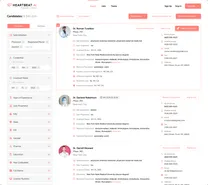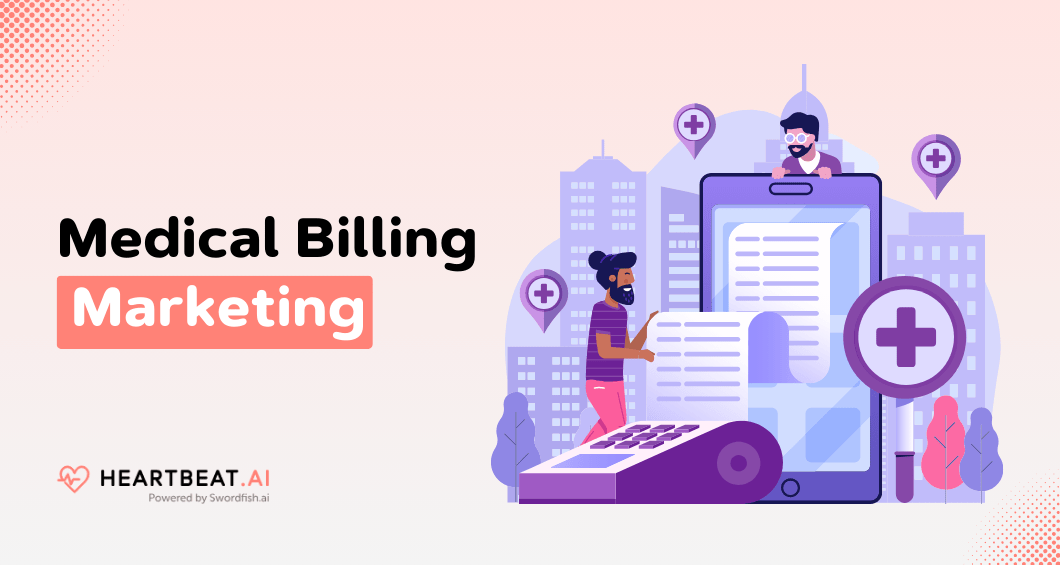
Do you know that the medical billing market is growing fast, with the industry witnessing a remarkable 15% annual growth in digital marketing spend?
If you’re in this business, it’s important to know the best ways to market your services. That’s why we’ve put together this guide. We’ve carefully crafted a comprehensive yet easy-to-follow guide, focusing on the essentials of medical billing marketing.
Everything is explained in simple steps, with no complicated words or business talk. So make sure to read all the way to the end to get the most out of these tips.
What’s on this page:
What Is Medical Billing Marketing?
Medical billing marketing is a specialized area focusing on promoting services dedicated to processing and managing medical claims and billing for healthcare providers. This form of marketing is crucial because it addresses a very specific need in the healthcare sector: efficient and accurate billing management.
The goal of medical billing marketing is not just to sell a service but to establish a relationship of trust and reliability with healthcare providers.
By demonstrating an in-depth understanding of the healthcare industry, medical billing companies can effectively position themselves as essential partners. They offer solutions that simplify billing processes, reduce errors, and improve financial efficiency, solidifying their role within the healthcare system.
What Are the Marketing Ideas for Medical Billing Services?
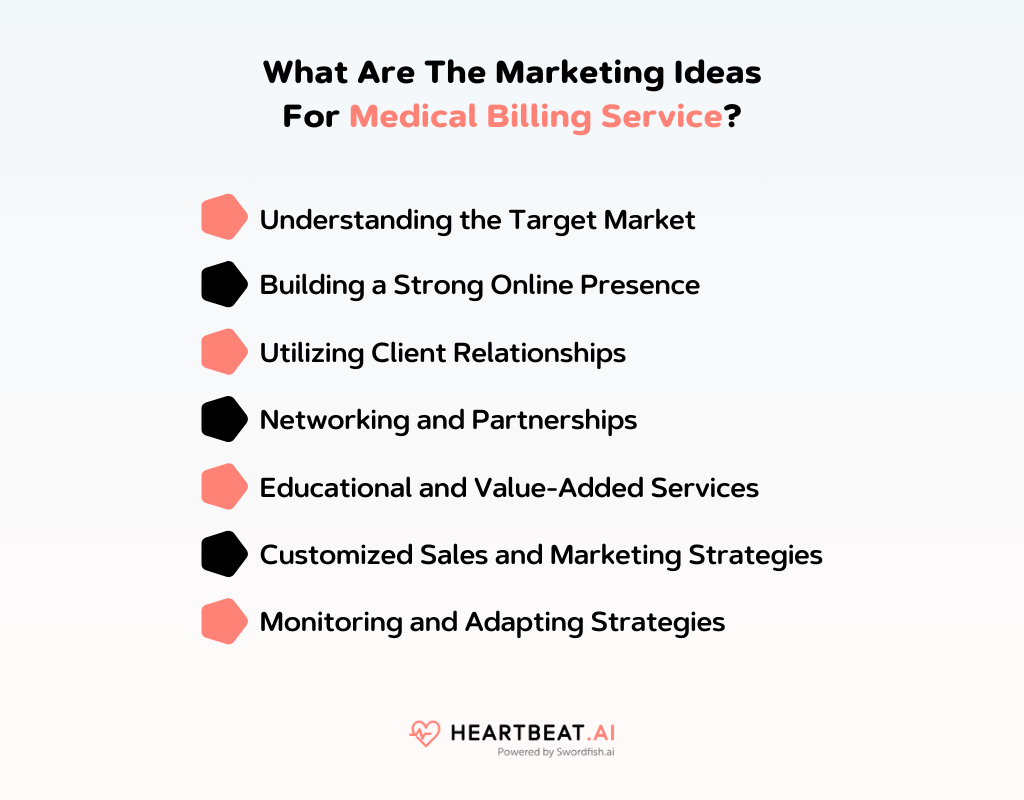
Marketing a medical billing service requires a blend of traditional business strategies and specialized approaches customized to the healthcare industry.
Here’s an exploration of marketing ideas for a medical billing service:
Understanding the Target Market
- Identifying the Target Audience: Medical billing services need to identify their target audience, which typically includes healthcare providers, clinics, hospitals, and sometimes individual practitioners. Understanding the needs, challenges, and pain points of these groups is crucial.
- Specialization and Niche Targeting: Some billing services may specialize in certain types of medicine, like dentistry, psychiatry, or general practice. Specializing in a niche can help in tailoring marketing messages more effectively.
Building a Strong Online Presence
- Website and SEO: A professional website acts as the digital front door for the medical billing service. It should be informative, user-friendly, and optimized for search engines (SEO). This ensures that when potential clients search for medical billing services, your website ranks high in search results.
- Content Marketing: Sharing valuable content like blogs, whitepapers, and case studies can establish the service as a thought leader in the medical billing space. This content should address common questions, industry trends, and best practices.
- Social Media Engagement: Platforms like LinkedIn can be particularly effective for B2B engagement. Regular posts, industry news updates, and participation in relevant conversations help in building a community around the brand.
Utilizing Client Relationships
- Testimonials and Case Studies: Positive reviews from existing clients can be powerful. Sharing testimonials and detailed case studies on various platforms can build credibility and trust.
- Referral Programs: Encouraging existing clients to refer new clients through incentives can be an effective strategy. Word-of-mouth is often a strong influencer in the healthcare industry.
Networking and Partnerships
- Industry Events and Conferences: Participating in medical and healthcare conferences, either as attendees or speakers, can help in networking and building brand visibility.
- Partnerships with Healthcare Providers: Forming partnerships with healthcare providers or associations can lead to mutually beneficial relationships. This can include offering exclusive services or discounts to members of these associations.
Educational and Value-Added Services
- Training and Workshops: Offering training sessions or workshops on medical billing processes, software, or compliance can be a way to add value and engage potential clients.
- Compliance and Regulation Guidance: Keeping up-to-date with healthcare regulations and helping clients navigate these can be a major selling point. This requires staying informed about changes in policies like HIPAA, ICD-10, etc.
Customized Sales and Marketing Strategies
- Personalized Approach: Understanding that each healthcare provider or facility has unique needs and customizing the sales pitch accordingly can be more effective than a one-size-fits-all approach.
- Multi-Channel Marketing: Utilizing a combination of digital (emails, newsletters) and traditional marketing methods (direct mail, print ads) to reach a broader audience.
Monitoring and Adapting Strategies
- Analytics and Feedback: Regularly analyzing marketing efforts through tools like Google Analytics, and collecting client feedback to understand what works and what doesn’t.
- Flexibility and Adaptation: The healthcare industry is constantly changing, so marketing strategies should be flexible and adaptable to changes in market trends and regulations.
What are the key elements of successful email marketing for medical billing?
Successful email marketing for medical billing involves a strategic approach that combines industry-specific insights with general best practices in email communication.
Let’s explore the key elements in detail:
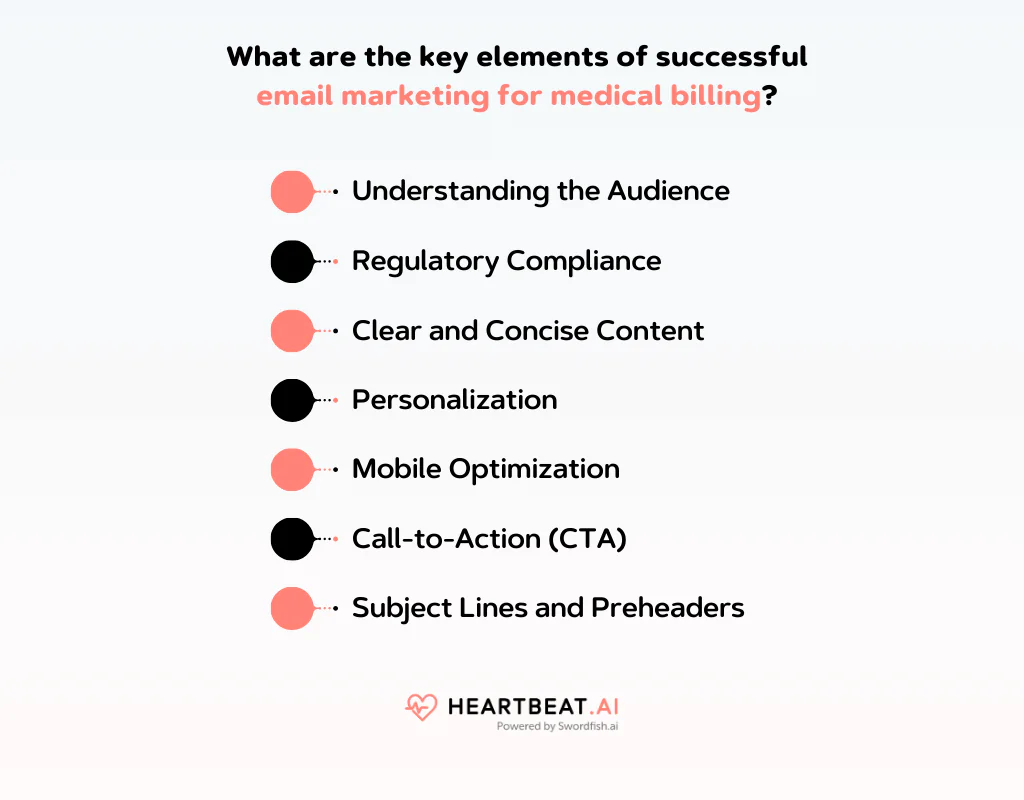
Understanding the Audience
The primary recipients of medical billing emails are usually patients, healthcare providers, and insurance companies. Customizing your message to each segment is crucial. For patients, focus on clarity and empathy, explaining bills in an understandable manner. For healthcare providers and insurers, emphasize accuracy, detail, and industry-specific terminology.
Regulatory Compliance
Adherence to healthcare regulations like HIPAA (Health Insurance Portability and Accountability Act) in the US is non-negotiable. Ensure all emails comply with privacy and security standards, especially when handling sensitive patient information.
Clear and Concise Content
Medical billing can be complex and confusing. Emails should break down the billing process into understandable terms, avoiding jargon as much as possible. Clarity also extends to the email’s structure – use headings, bullet points, and short paragraphs to make the content easily digestible.
Personalization
Personalizing emails increases engagement. This can range from simple steps like using the recipient’s name to more complex personalization based on their billing history or interactions with the healthcare system.
Mobile Optimization
With an increasing number of emails being read on mobile devices, ensure your emails are mobile-friendly. This includes responsive design, readable fonts, and accessible layouts.
Call-to-Action (CTA)
Be clear about what you want the recipient to do next – whether it’s paying a bill, contacting customer service, or reviewing a statement. The CTA should be prominently displayed and easy to follow.
Subject Lines and Preheaders
The subject line is your first, and sometimes only, chance to capture the recipient’s attention. It should be relevant, concise, and engaging. The preheader text (the summary text that follows the subject line) also plays a crucial role in convincing recipients to open the email.
What Strategies are Most Effective for Medical Billing Digital Marketing?
Effective digital marketing strategies for medical billing require a careful blend of industry knowledge, technical expertise, and marketing awareness.
Here are some key strategies:
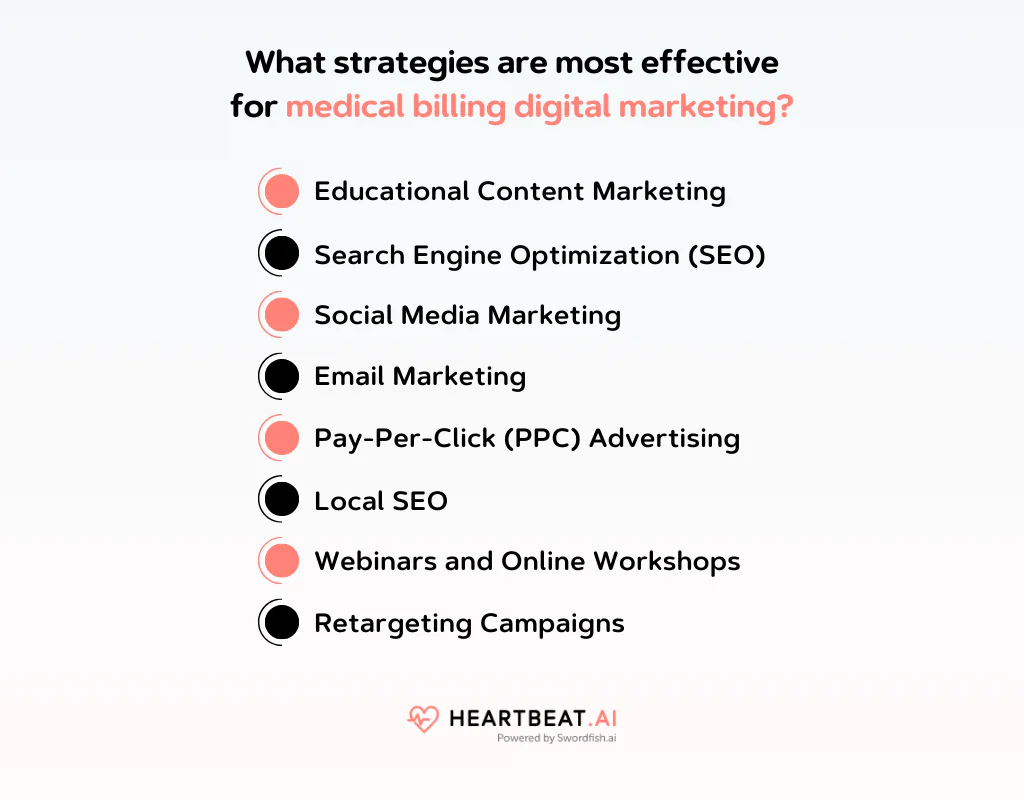
| Element | Description |
| Audience Customization | Customize messages for patients, providers, and insurers. Prioritize clarity and accuracy. |
| Compliance | Adhere to HIPAA and healthcare regulations for privacy and security. |
| Clear Content | Simplify billing terms, and avoid jargon. Use concise formats for better understanding. |
| Personalization | Boost engagement by using the recipient’s name and personalized content based on history. |
| Mobile Optimization | Ensure mobile-friendly emails with responsive design and readable layouts. |
| CTA Effectiveness | Clearly state desired actions with prominent, easy-to-follow calls-to-action. |
| Subject & Preheader | Craft engaging subject lines and utilize preheaders for enticing email previews. |
Educational Content Marketing
Given the complexity of medical billing, content that educates your audience can be highly effective. This could include blog posts, infographics, videos, and webinars that explain various aspects of medical billing. Such content can position your company as a thought leader and a trusted source of information.
Search Engine Optimization (SEO)
Optimizing your website and content for search engines is crucial. This means using relevant keywords, creating quality content, and ensuring your website is user-friendly and mobile-responsive. SEO helps your website rank higher in search engine results, making it easier for potential clients to find you.
Social Media Marketing
Utilizing social media platforms can help you reach a broader audience. Platforms like LinkedIn are particularly useful for B2B marketing in the medical billing sector. Sharing insightful content, industry news, and company updates can help build your brand’s reputation and engage with potential clients.
Email Marketing
As a direct line of communication, email marketing can be very effective for nurturing leads and keeping current clients informed. Segmenting your email list allows for more targeted and relevant communications. For instance, you might have different email content for healthcare providers versus insurance companies.
Pay-Per-Click (PPC) Advertising
PPC advertisements have the potential to increase targeted website traffic, particularly on networks like Google Ads. You can use PPC to promote specific services, special offers, or your educational content. The key is to target the right keywords and create compelling ad copy.
Local SEO
If your medical billing service targets local healthcare providers, optimizing for local SEO is essential. This includes claiming your Google My Business listing, getting listed in local directories, and using location-specific keywords in your content.
Webinars and Online Workshops
Hosting webinars and online workshops on topics related to medical billing can attract a significant audience. These events provide an opportunity to showcase your expertise and engage with potential clients in real time.
Retargeting Campaigns
Retargeting ads to individuals who have visited your website but haven’t converted can be an effective way to keep your brand top of mind. These campaigns typically have higher conversion rates since they target people already familiar with your brand.
How can Heartbeat AI Enhance the Effectiveness of Medical Billing Marketing Strategies?
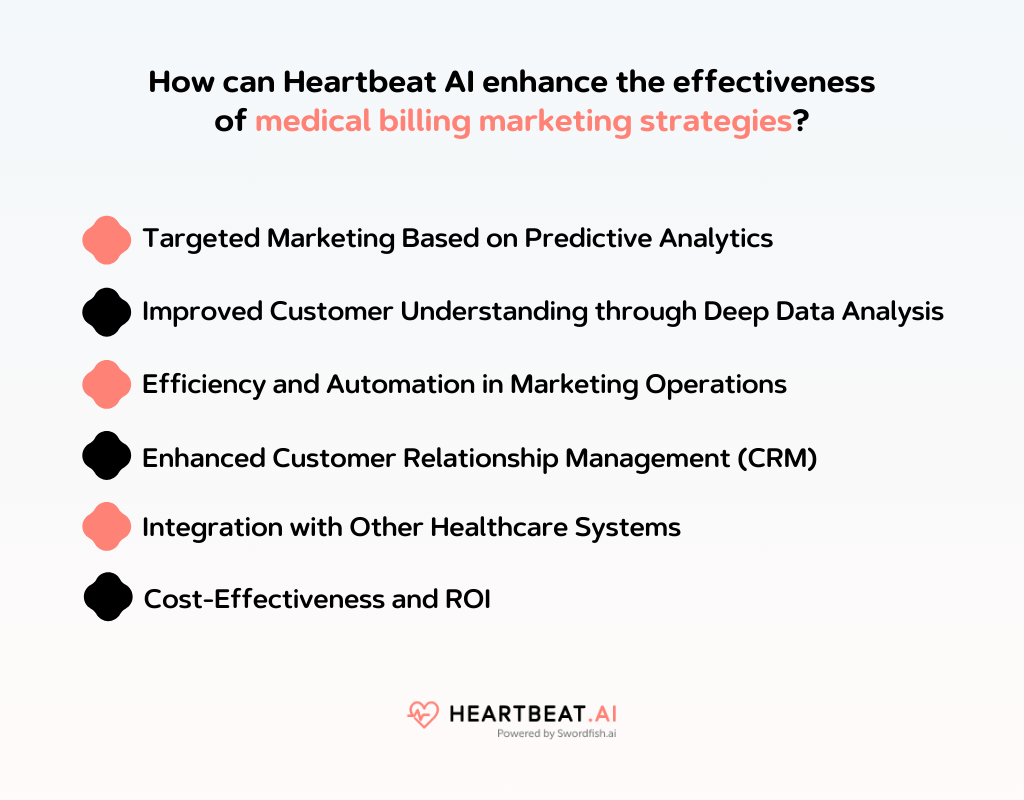
Heartbeat AI, is an exceptional tool, simplifying the search for ideal industry candidates with speed and efficiency in the healthcare industry. It can significantly enhance the effectiveness of medical billing marketing strategies in several ways. Let’s look into this fascinating intersection of technology and healthcare marketing.
Targeted Marketing Based on Predictive Analytics
Heartbeat AI utilizes predictive analytics to refine targeted marketing. This ensures campaigns are highly personalized and timed perfectly to meet the emerging needs and preferences of specific demographic and behavioral segments.
- Personalized Campaigns: Our vast database meticulously analyzes extensive patient data to pinpoint specific needs and preferences. This enables us to craft highly personalized marketing campaigns, focusing on individuals most likely to require particular medical services or billing options.
- Predictive Modelling: We anticipate future healthcare trends, shaping our marketing strategies to meet emerging demands, thereby keeping our billing services ahead of the curve.
Improved Customer Understanding through Deep Data Analysis
Using deep data analysis, Heartbeat AI gains profound insights into patient demographics and behaviors. This enables precision in tailoring marketing messages and billing options for individualized engagement.
- Demographic Insights: Our Heartbeat Prospector is able to parse and comprehend intricate demographic data allows us to target marketing efforts effectively across different age groups, regions, and other demographic segments.
- Behavioral Analysis: We examine patient behaviors, like payment histories and interactions with healthcare providers, to tailor billing options and marketing messages to align with individual patient preferences.
Efficiency and Automation in Marketing Operations
Heartbeat AI simplifies marketing operations through automation, efficiently managing routine tasks such as email campaigns. It also adapts strategies in real-time to capitalize on emerging healthcare trends and feedback.
- Automated Marketing Tools: At Heartbeat, we automate routine tasks such as email campaigns and social media posts, and can even handle basic customer queries.
- Real-Time Adjustments: Capable of processing data instantaneously, we swiftly tweak marketing strategies in response to current trends, feedback, or shifts in the healthcare landscape.
Enhanced Customer Relationship Management (CRM)
Heartbeat AI elevates CRM with AI-driven personalization, analyzing patient interaction history for timely and relevant communication. It also continuously improves services through meticulous feedback analysis.
- Personalized Communication: Utilizing AI to analyze patient interaction history, we ensure communication is always relevant, timely, and personalized.
- Feedback Analysis: We evaluate feedback from patients and healthcare providers, enabling continuous enhancement of both our billing services and marketing strategies.
Integration with Other Healthcare Systems
Heartbeat AI integrates with healthcare systems, enhancing marketing strategy by providing a holistic patient view.
- Seamless Integration: Our AI integrates with other healthcare systems, like EHRs, providing a holistic view of the patient journey and enhancing the relevance and timing of the marketing strategies.
Cost-Effectiveness and ROI
Heartbeat AI ensures cost-effectiveness with precise targeting and simplified operations, ultimately leading to a better return on investment (ROI).
- Optimized Marketing Spend: With targeted precision and efficient operations, we reduce unnecessary expenditures, ensuring a better return on investment.
- Tracking and Reporting: We utilize detailed analytics on marketing campaign performance to fine-tune our strategies for maximal effectiveness.
Conclusion
So far in this guide, we’ve explored the medical billing marketing tips. Remember, effective marketing is crucial in this field. It not only helps you connect with the right audience but also establishes your expertise and trustworthiness.
By following the strategies outlined, you can navigate the competitive industry more effectively and grow your business. We encourage you to apply these strategies consistently for a successful medical billing venture. Your journey toward growth and success in this specialized industry starts here.
Frequently Asked Question
Is the medical billing business profitable?
Yes, the medical billing business can be profitable due to the constant demand for accurate billing services in the healthcare industry.
How much does a medical billing business make?
The earnings of a medical billing business vary widely depending on factors like client base and efficiency. But it can generate an annual revenue ranging from $30,000 to $100,000 or more.
How can you stay ahead of evolving trends in medical billing?
To stay ahead, regularly update your knowledge on coding changes, technology advancements, and healthcare regulations. Networking with industry peers and investing in modern software are also crucial for success.

